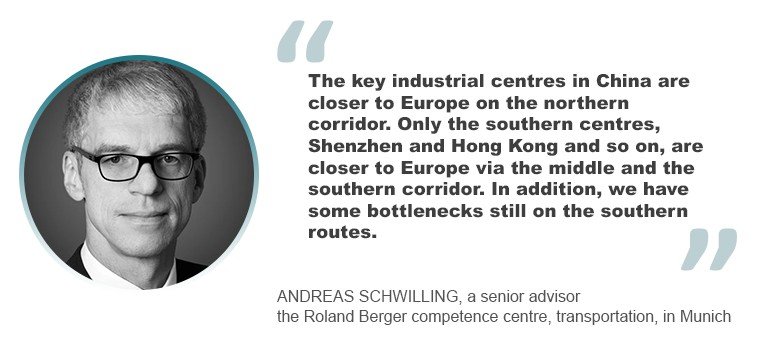A southern rail route between China and Europe which could effectively redesign transport out of China, especially Guangdong, is being suggested, although some big problems first need to be overcome, a breakout session of the European Silk Road Summit in Amsterdam was told.
“Southern route” is usually taken to mean from China via the Commonwealth of Independent States (CIS) – effectively parts of the former Soviet Union, such as Turkmenistan, Uzbekistan and Kazakhstan – then Iran and Turkey before entering Europe via its southeast flank. It is known to be the least-developed of the Euro-Asia routes; even if this developed, it is likely to remain the smallest of the three routes.
“The key industrial centres in China are closer to Europe on the northern corridor. Only the southern centres, Shenzhen and Hong Kong and so on, are closer to Europe via the middle and the southern corridor,” Andreas Schwilling, a senior advisor in the Roland Berger competence centre, transportation, in Munich, told the session. “In addition, we have some bottlenecks still on the southern routes.”

By contrast, the northern route via China then Russia has a natural catchment and works off the industrial clusters in northern and central China, as does the middle or Caspian Sea route, which goes through China and Kazakhstan.
Another part of this problem is the small volumes involved. Schwilling said the route could develop to almost 400,000 TEUs, but only some 73,000 TEUs, he estimated, is going end-to-end. The rest is likely to be shorter, maybe just cross-border movements, he added.
That said, the push for a southern route is starting, or at least putting itself forward, but with many aware of the problems it faces, there is scepticism.
One of the big obstacles is the lack of a driving force to push through reforms down the line. “What we lack is big integrators,” said Schwilling, who added “It’s a lot of work to get this integrated.”
Complicating the lack of that key driver are some geographical problems: in particular, two seas, the Caspian and the Black, where goods can be moved by ferries. These are dependent on the weather and are usually done on a charter basis – and, according to Schwilling, often done by old vessels.
The other geographical problem is political: more borders mean more governments to deal with, and also more customs agencies. “This really is key,” Schwilling said. And then there is politics, such as Russia and its clash with Ukraine, Turkey and its problems with other parts of Europe and, in the middle of it all, Iran, which in addition to its tenuous relationship with several of its neighbours, brings with the vexing issue of sanctions, making it “not accessible to Western companies.”
In Turkmenistan, CAREC (the Central Asia Regional Economic Cooperation Programme) is supporting modernization of railways between Turkmenabat, Mary, Ashgabat and Turkmenbashi.
There is also a China-Turkmenistan-Uzbekistan corridor initiative, and there has been the launch of the Bereket-Etrek-Turkmenistan-Iran Border Railway after the government of Turkmenistan received funding from the Islamic Development Bank.
CAREC is also supporting Azerbaijan’s modernization of Baku-Yalama and Alat-Astara railways to increase speed from 40 km/h to 120 km/h. This is currently under construction, Schwilling noted. (CAREC is also involved in the construction of a new railroad link to connect Anaklia in western Georgia to the rest of the country’s rail network, he said.)
Also in Azerbaijan is the International North-South Transport Corridor, which has seen modernization of the 167 km Sumgait-Yalama Railway section as a response to the reconstruction of the Baku-Sumgait section to enable time and cost savings for cargo operations.
Paradoxically, the biggest cluster is the place the fewest can go to easily: Iran.
Here, electrification and upgrade of the 926-km Tehran-Mashhad line is currently under way. In December 2019, Iran and Azerbaijan started construction of the 130-km Rasht-Astara railway that will link Iran with Astara on the Iran-Azerbaijan border. Another part of this, also currently under construction, is a railway to connect Chabahar, Iran’s freeport on the Gulf of Oman, to the rest of its rail network. This is due to be finished in three years, Schwilling said.
But the North-South Transport Corridor is so much more than this, according to Amir Asri, international rail business development manager at MAPNA Locomotive in Tehran. The Corridor aims to provide a link not just from Iran’s ports to its borders but onwards to Russia, Turkey, Central Asia, neighbouring Iraq and by ferry to some of the Gulf States.
It will reduce by “maybe 25, maybe 30 days,” the 45-60 days cargo usually takes to go via the Suez Canal, but it also has the feel of a new, alternate hub. Like the southern corridor it is attaching itself to, it might have to sort out some hefty political problems before it achieves that goal.


